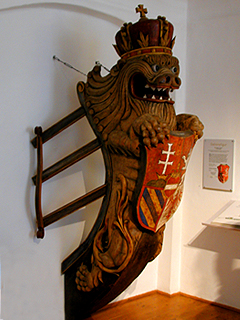Some 40.000 years ago, the first modern humans arrived in Central Europe, having followed the River Danube upstream from the Balkans. Thousands of years later, while the upper reaches of the Danube were known as Fluvius Danubius, the lower reaches were known as the Ister and it was unknown whether these words referred to one or two rivers. For the Romans, the Danube was both a waterway and a natural barrier. The southern reaches, which correspond to the Ister, were used for transport. Although ships were equipped with sails, in order to go upstream, they were pulled by gangs of slaves. In the section known as The Iron Gates, on the Serbian-Roumanian border, paths for the slaves were cut into the cliffs and extended outwards with beams of wood. Known as Trajan’s Road, following the building of a hydroelectric plant, the path now lies under 30 metres of water and only photographs show the carved walkways.
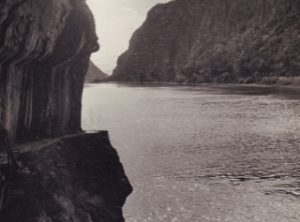
At the Shipping Museum in Spitz, a model shows a Roman merchant ship of the kind used on the lower reaches of the Danube.
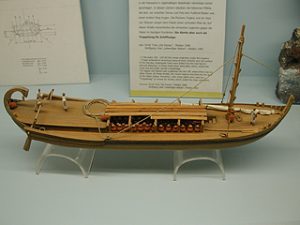
Meanwhile, to the North, Fluvius Danubius was a natural barrier that marked the northern limits of the Empire. Here a very different kind of vessel was in use and the river was patrolled by skiffs that were rowed by 20 legonaries.
image coming soon
During the Roman Era, the Danube was bridged at two places. At The Iron Gates, to facilitate campagains, Trajan had a wooden bridge built that rested on brick, stone and concrete supports. At the time, this was the longest known bridge in the world. Much further North, a similar construction spanned the Danube at Steppenberg in Germany. Inbetween, there were no bridges and for military campagains, the Romans would make pontoon bridges by tying boats together. In certain places, the river was broad enough for it to be forded by people on horseback. Over the ages there were also numerous ferries at various points. The most substantial form of ferry was a form of raft that was attached to a hawser. The haweser was strung across the river from masts set up on either side of the bank. When the rudder was turned hard over, the ferry would be pushed across the river by the force of the current on the rudder. At Spitz and Weissenkirchen two ferries of this kind are in operation and carry cars, cyclists and foot passengers across the river. A similar ferry was also in operation at Dürnstein. Today only the foundations of the southern mast are locatable among the undergrowth. This is East of the Roman outlook tower at Hohe Wand.
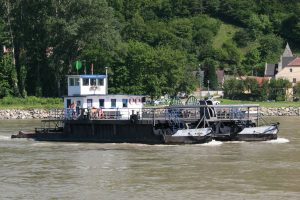
A long lost feature of the Danube, were floating mills. Secured to the river bank, these were also powered by the current.
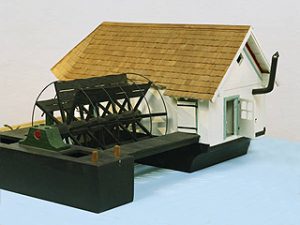
The setting up and operation of such a mill required a permit. Also requiring a permit was gold panning. In the monastery at Melk a chalice may be seen that was made with gold panned on the Danube.
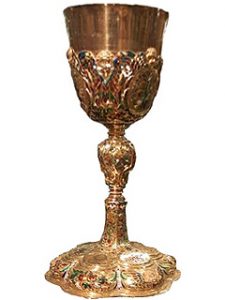
This leads back to the Ister, Fluvius Danubius and the uncertainty as to whether the two were a single river or not. This is because in the story of Jason and the Argonauts, the Golden Fleece that Jason is given the task of securing, is a fleece laced with gold dust from gold panning operations in Thrace. Depending on how the scanty directions given by Apollonios of Rhodes in his Argonautica of the third century BC are read, the waters refered to are either one river or two.
image coming soon
Prior to the introduction of steam shipping on the Danube, conveys of barges were laboriously hauled upstream by Schiffersleute or „boatmen“, who worked in teams that involved up to a hundred people and as many horses.
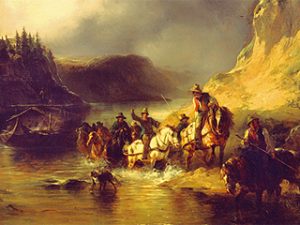
Unlike Trajan’s Road, the towpath was neither extensive nor permanent and there were long stretches where there was no path and only a treacherous patchwork of ox-bow lakes, bogs and wet-patches. At the front of a convey there would be a lone figure mounted on a horse, who with a pole would endeavour to sound out the way ahead. Sometimes all that one saw of the Wagehals or „daredevil“, was the head of his horse and the head and shoulders of the rider.
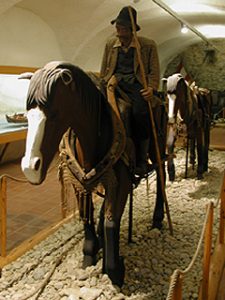
The horses were shire horses and were arranged in pairs, with each pair having a driver who rode on one of the horses. Apart from being strong, the horses specially trained so as to be able to jump into barges, wade through water and not to get themselves caught in the 60 metre long hawsers that they pulled. A convey typically consisted of three freight barges, in front of which there were smaller boats, with short stubby masts and it was over the masts of these vessels, that the tow-rope was hung. This was so as to prevent the tow-rope from touching the water. Where at sea, the dried salt was enough to prevent ropes and cordage from rotting, inland, fresh water quickly rotted ropes made from natural fibres. The overriding imperative was therefore to never allow the tow-rope to get wet. After the freight barges, the last vessels of a convey were the supply ship, followed by a galley boat where cooks worked hard to cater for the crews and riders. Conveys were often 500 Metres long and for the 450 Kilometre journey from Vienna to Regensburg, between six and eight weeks were needed. Starting and stopping a convey was slow and time-consuming process and when it was necessary to change over from one bank to the other, the operation would take a whole day. The village of Rossatz, which lies opposite Dürnstein, is so named as a little further upstream, there is a sharp bend in the river that cannot be negotiated on the inside by a convey of vessels going upstream.
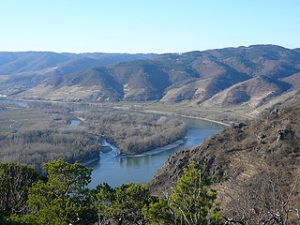
The bend is however wide and was shallow enough to vessels and horses to be moved across from one side to the other. From the merging together of the words Ross for „horse“ (or Rösse for „horses“) and umsetzen, to „change over“, the name „Rossatz“ emereged as the name of the village near where this was done. Meanwhile the passage downstream was a process of controlled drifting achieved through the use oars. During the first half of the nineteenth century, some 850 barges were floated downstream to Vienna every year while only 350 were pulled upstream. This is because the costs of a convey were such that barges were seen as being semi-disposable and empty barges were never pulled upstream.
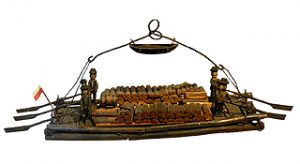
A model of a raft in Museum Krems
Wherever possible rafts were used and large timbers were transported on rafts that were made using the timbers to be transported. Conveys were captained by „ship masters“, who acted as entrepreneurs‘ and managed trafficking operations along the Danube. One ship master, Matthias Feldmüller from Ybbs, would sometimes build 40 barges a year and at peak times, would employ 250 people and have 150 horses in use. In the Wachau, a ship master’s house and office can be seen, overlooking the river, at the upstream end of Spitz.
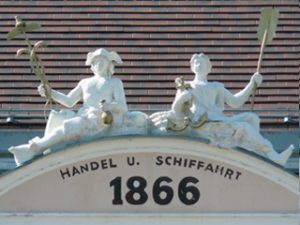
Where barges were semi-disposable and human hands were hired, a ship master’s capital costs lay in his horses. On long journeys, horses were changed and were ferried about in Zillen. These are long, narrow punts with pointed ends. Still in use today, in close quarters they are paddled but are otherwise pushed through the water by means of long poles.
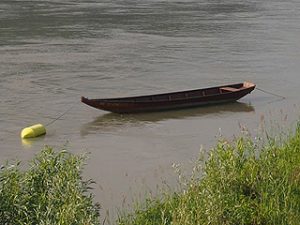
The various kinds of vessels used by the shippers were built at a number of towns along the Danube with there being a large naval shipyard at Klosterneuburg. On 14th April, 1768 in the presence of Empress Maria Theresia and co-regent Joseph II, this was where the frigate „Theresia“ was launched. Twenty-six metres in length, this was the last sailing warship on the Danube built and the figurehead of the ship is on display at The Museum of Shipping in Spitz. Also displayed is a 1:20 scale cut away model of the vessel which in 2000, won the International Model Ship Competition.
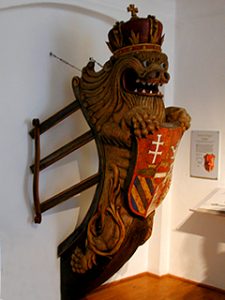
Clearly sign posted and housed in a Baroque palace, The Museum of Shipping is open daily from the beginning of April up until the end of October from 10.00 a.m. to 4.00 p.m.
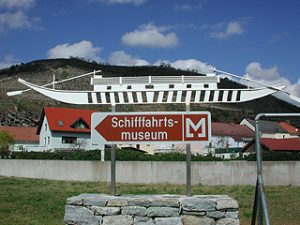
In addition to shipbuilders, along the Danube, there were saddle-makers, rope-makers, carpenters and people who would help with loading and unloading. During the winter months, there was no shipping and the shippers would either return to their wives or hole up with colleagues in a town by the river. Gregarious, the shippers would spend their time in taverns and would work on preparations for the carnival that concluded the winter period. For some, the word „carnival“ derives from the Latin, vale carne, announcing the arrival of Lent with a bidding farewell to the eating of meat. Yet for others, it derives from, carrus navalis and refers to the „ship-cart“ or float that, followed by a procession of boatmen dressed as fools, would be pulled through the streets when the ice and snow of winter began to thaw, heralding the time when the shippers could once again take to the river. Among women, the advice was „Never marry a shipper, in the summer you’ll have no husband, in the winter you’ll have no money“. In Stein, Christine Emberger offers a tour through the town, dressed in the role of the Nineteenth Century shipper, Jacob, with this being an excellent way of experiencing the lost world of river transport on the Danube, that complments and expands upon what may be seen and learnt in the Shipping Museum at Spitz.
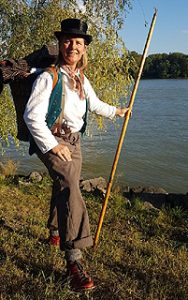
In 1829, „The First Royal and Imperially Warranted Danube Steamship Company“ was formed and in 1830, the first steamship set out from Vienna, arriving in Budapest 14 hours later. Although the return journey took 48 hours, the trip was a sensation and was considered such a success that a regular service was quickly established. From the 1850’ies onwards, the demands for steamships and faster travel lead to nearly all Austrian reaches of the once meandering Danube being straightened out, with rapids and cataracts being dredged and outcrops of rock being blasted away. At the Shipping Museum in Spitz a model of the diesel powered paddle steamer, „Persenbeug“ may be seen. This was launched in 1923 and the vessel had a number of sister ships including the „Krems“
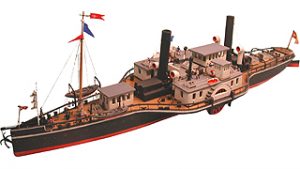
Where the first steamships carried people, by the 1870’ies, the river was straightened and regulated enough for steam-powered freight shipping to undermine traditional barge transport and thousands of boatmen were deprived of their livelihood. To keep the newly regulated reaches navigable, ships would drag specially constructed ploughs along the bed of the river.
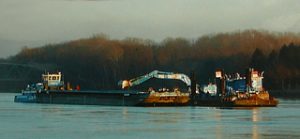
With the introduction of the internal combustion engine, the amount of people required to operate a ship was further reduced and freight ships are now manned by two or three people conveying an amount of cargo that is comparable to and often exceeds, the tonnage that was carried by a traditional horse drawn convey of three barges and a hundred men.
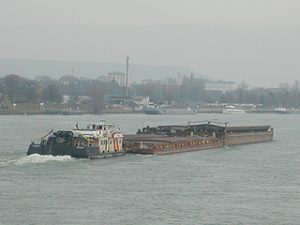
At the Shipping Museum in Spitz, models, life-size replicas and all manner of period artefacts bring the lost world of the shippers to life. Following the precedent given by Yugoslavia, along the Austrian reaches of the river, only the Wachau has been able to retain its age-old appearance. Yet in the 1970’ies, even this short stretch was threatened by plans for a hydroelectric power station and it took a local initiative to prevent what is now a UNESCO World Heritage Site from being flooded. A short way downriver from Krems, a view of the Danube just above the dam at Greifenstein shows the monotony for the natural world that regulation invariably brings with it.
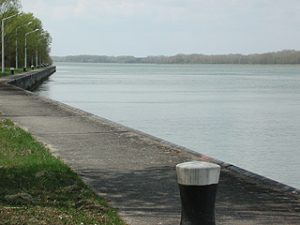
The heavily regulated Danube thus stands as a reminder not only of how mechanisation has successively erroded the position of the human worker in society but also as an image of the modern world and its relation to the environment.


